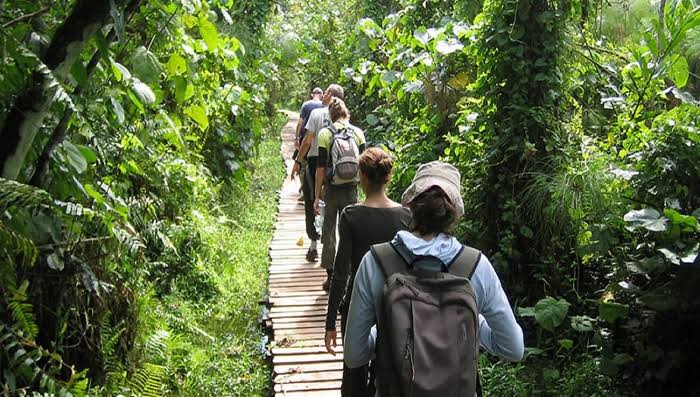
Kibale National Park, in Uganda’s heart, showcases the nation’s dedication to preserving its natural heritage. This vibrant sanctuary is a biodiverse haven, home to an array of flora and fauna in lush African landscapes.
Location and Geography
Kibale National Park, covering an area of approximately 795 square kilometers, is situated in southwestern Uganda, close to the border with the Democratic Republic of Congo. It is part of the Western Rift Valley and is characterized by its diverse topography, which includes both lowland tropical rainforest and highland terrain. The park’s varied landscapes, ranging from swampy areas to rugged hills, provide a wide range of ecosystems, making it an ecological hotspot in the region.
Biodiversity
- Primates: Kibale National Park is renowned for its thriving populations of primates, including the star attractions, and chimpanzees. With over 1,500 chimpanzees, it boasts one of the largest communities of these intelligent creatures in Africa. Guided chimpanzee tracking tours offer visitors a chance to witness these fascinating animals up close. Apart from chimpanzees, the park is home to 12 other primate species, such as the red-tailed monkey, L’Hoest’s monkey, and black-and-white colobus monkey. It’s a primate enthusiast’s dream come true.
- Birdlife: Birdwatchers will be delighted to explore Kibale’s diverse avian population. The park boasts over 350 bird species, including the rare green-breasted pitta and the African grey parrot. The canopy walkway provides an excellent vantage point to observe these magnificent creatures in their natural habitat.
- Flora: The park’s rich vegetation includes a mix of tropical rainforest, grasslands, and wetlands. You’ll find towering trees, colorful orchids, and various medicinal plants. It’s a treasure trove for botany enthusiasts and a vital resource for researchers.
Activities and Attractions
- Chimpanzee Tracking: The most popular activity in Kibale National Park is chimpanzee tracking. Skilled guides lead visitors through the forest, helping them spot and learn about these incredible primates.
- Bird Watching: Birdwatchers can spend hours observing and photographing the park’s diverse bird species. The Bigodi Wetland Sanctuary, adjacent to the park, is a fantastic spot for birdwatching.
- Guided Nature Walks: Guided nature walks provide an opportunity to explore the park’s flora and fauna in more depth. Experienced guides will share their knowledge of the park’s ecology and culture.
- Canopy Walk: The treetop canopy walkway offers a unique perspective of the rainforest, allowing visitors to see the forest from a different angle and spot various wildlife from above.
Conservation Efforts
Kibale National Park plays a crucial role in the conservation of Uganda’s natural heritage. Efforts have been made to protect its ecosystems and the endangered species that call it home. The park is part of the Greater Virunga Landscape, a transboundary conservation initiative aimed at safeguarding the region’s biodiversity.
Visitors are encouraged to follow strict guidelines during their visits to minimize their impact on the park’s delicate ecosystems, and revenue generated from tourism helps fund conservation efforts.
Conclusion
Kibale National Park is a testament to Uganda’s commitment to preserving its rich natural heritage. From its incredible primate populations to its diverse birdlife and lush rainforests, the park offers an unforgettable experience for nature enthusiasts and adventurers alike. As we continue to recognize the importance of protecting our planet’s biodiversity, Kibale National Park stands as a shining example of what can be achieved through conservation and responsible tourism. A visit to this pristine gem in Uganda is not just a journey into the wild but also a journey toward understanding and appreciating the remarkable beauty of our natural world.
Eplore Sentas Tours Packages to get to Kibale National Park


